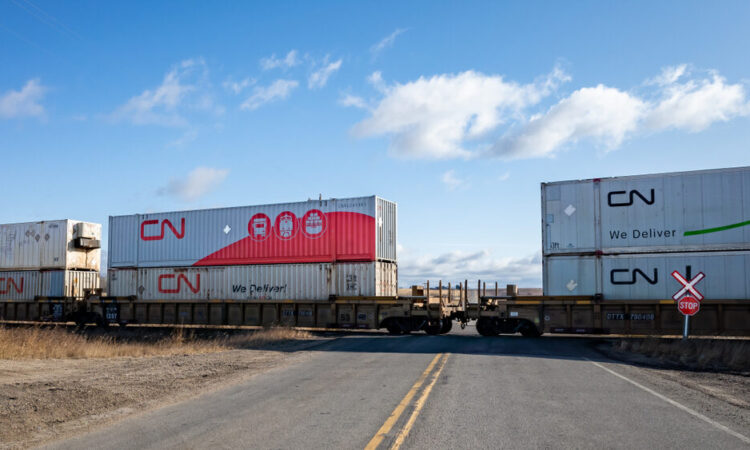The Class I railroads are striving to collaborate more proactively and create a product that can be competitive against the truck markets, CN executives said during the Canadian railway’s earnings call Tuesday to discuss third-quarter 2023 financial results.
The comments echo ones similarly expressed during the third-quarter earnings call for Eastern U.S. Class I rail carrier CSX last week.
“I think it is a change that we’re seeing in the industry for various reasons,” CN President and CEO Tracy Robinson said to investors during the call. “I will tell you that we are open for business and very eager to work with our partners and the other carriers to provide and design the services that make sense for our customers.”
The ones that have been announced recently, such as the partnership with Western U.S. Class I railroad Union Pacific and Grupo Mexico and another partnership with Eastern U.S. Class I carrier Norfolk Southern, “are really targeting getting truck traffic off the road. … We have a product in place now that’s consistently delivering at very truck-like transits. And that’s pretty remarkable,” Robinson said.
“I think you’re going to see more of this. And I would say that the nature of the dialogues that we’ve had so far with all of the carriers is that we’ll conduct ourselves in a way as though we were a single carrier. And that may mean, in some cases, it’s advantageous to one and in another case is advantageous to the other. But that’s a principle that I think needs to underscore these relationships as we go forward.”
Ensuring faster rail transport is also a shared goal within these partnerships, according to CN Chief Marketing Officer Doug MacDonald.
“It’s all about service. The quickest transit times to compete against truck is really what the operating teams between the railways are really focused on,” MacDonald said. “We don’t really care how long the haul is. It’s all about we need to get there as fast as truck. All the teams have been greatly focused on that. They’ve come up with some great products where we think we’re truck competitive in all these corridors and the major truck lanes.”
CN executives also touted the benefits of being the one Class I rail carrier to have exclusive access to the Port of Prince Rupert in British Columbia. Robinson singled out CN’s premium container service from Prince Rupert to U.S. markets as one example.
“There are real structural advantages to Rupert. … We’re two days faster from China to Chicago than the other alternatives and there are some economic advantages,” such as being tied to Canadian currency, Robinson said.
The Port of Prince Rupert announced that it is starting construction on a project to expand rail-to-container transloading capacity at Ridley Island and better facilitate the export of agricultural, forestry and plastic resin products.
And ahead of releasing its third-quarter earnings results, CN said Monday in a separate announcement that it had renewed a five-year transportation agreement with AltaGas. The agreement, which CN says expands the existing one, gives AltaGas access to the Port of Prince Rupert and should enable AltaGas to grow its export business.
“By selling into our capacity and taking advantage of our unique network reach, we are confident in our ability to accelerate sustainable, profitable growth,” Robinson said in Monday’s announcement.
AltaGas President and CEO Vern Yu said, “The agreement provides AltaGas and our customers with cost and service predictability to continue to support ongoing resource development across Western Canada and provide our key downstream customers with energy security to support economic activity and fuel everyday life.”
CN Q3 2023 financial results
A 12% decrease in revenue contributed to lower net profits for CN (NYSE: CNI) in the third quarter.
Net income was CA$1.12 billion (US$806.3 million), or $1.69 per diluted share, for the third quarter of 2023, compared with nearly $1.46 billion, or $2.13 per diluted share, for the third quarter of 2022. All financial figures are in Canadian dollars.
Revenue was $3.99 billion in the third quarter, compared with $4.5 billion for the third quarter of 2022. Lower fuel surcharge revenues as a result of lower fuel prices, as well as lower volumes of intermodal, crude oil and forest products, put pressure on revenue, CN said.
Lower volumes were due to lower demand for freight services to move consumer goods, the negative impact of the Pacific Coast dockworkers strike, unfavorable crude oil price spreads and weaker market conditions for lumber and panels as well as lower ancillary services including container storage, CN continued.
Freight rate increases, higher volumes of Canadian grain and potash and the positive translation impact of a weaker Canadian dollar were among the factors that lent support to third-quarter volumes, according to CN.
Operating expenses were $2.47 billion for the third quarter, an 11% decrease year over year (y/y) amid lower fuel prices.
Operating income was $1.52 billion, 21% higher compared with the third quarter of 2022, while operating ratio, an indicator that investors sometimes use to gauge the financial health of a company, was 62% compared with 57.2% y/y. A lower OR implies improved financial health.
“Our ‘Make the Plan, Run the Plan, Sell the Plan’ approach continued to perform well, delivering strong customer service despite weak consumer demand as well as external challenges,” Robinson said in a news release. “As volumes continue to improve, we are well positioned to deliver incremental operating leverage. We remain confident in our ability to accelerate sustainable, profitable growth in 2024 through 2026.”


